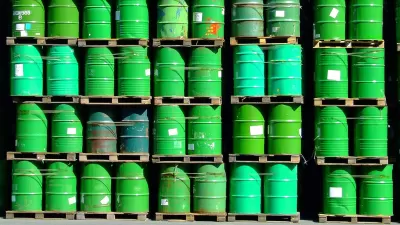There's a glut of ethanol on the market, and the solutions to consume it are not easy. The maximum blend in gasoline is 10% before it affects the catalytic converter, and E85 can't compete with the more efficient, though more expensive, gasoline.
"When Congress wrote the rules (increasing usage of ethanol) in 2007, gasoline consumption had been growing for years.
Gasoline consumption hit a peak of 3.4 billion barrels that year and then fell to 3.3 billion barrels last year, and it could end 2009 at about the same level."
It's clear that it will be very difficult, if not impossible to reach the mandate of 15 billion gallons of biofuels by 2012, or 36 billion gallons in 2022, up from less than seven billion gallons in 2007.
"As of yet, not all gasoline is blended with 10 percent ethanol, but that saturation point is rapidly approaching.
As for E85, the problem is that at current prices, it does not make economic sense for drivers, and most of them use regular gasoline in their flex-fuel cars.
Gasoline was selling on average Thursday (11/26) for $2.63 a gallon, while E85 was selling for $2.23 a gallon. That might make E85 sound like a bargain, but cars go fewer miles on a gallon of ethanol than of gasoline. Adjusted for that factor, E85 on Thursday was effectively 31 cents a gallon more expensive than gasoline.
A return of $4 gasoline might change things, by making E85 a relative bargain and spurring wider use. So would an unexpected spurt in total fuel demand. Otherwise, it is not at all clear how the nation's coming surplus of ethanol can be absorbed."
Contributor's comment: Another solution would be for Congress to add a 'fossil fuel fee per gallon' so that E85 becomes more competitive with gasoline.
FULL STORY: U.S. Unlikely to Use the Ethanol Congress Ordered

Alabama: Trump Terminates Settlements for Black Communities Harmed By Raw Sewage
Trump deemed the landmark civil rights agreement “illegal DEI and environmental justice policy.”

Planetizen Federal Action Tracker
A weekly monitor of how Trump’s orders and actions are impacting planners and planning in America.

The 120 Year Old Tiny Home Villages That Sheltered San Francisco’s Earthquake Refugees
More than a century ago, San Francisco mobilized to house thousands of residents displaced by the 1906 earthquake. Could their strategy offer a model for the present?

Indy Neighborhood Group Builds Temporary Multi-Use Path
Community members, aided in part by funding from the city, repurposed a vehicle lane to create a protected bike and pedestrian path for the summer season.

Congestion Pricing Drops Holland Tunnel Delays by 65 Percent
New York City’s contentious tolling program has yielded improved traffic and roughly $100 million in revenue for the MTA.

In Both Crashes and Crime, Public Transportation is Far Safer than Driving
Contrary to popular assumptions, public transportation has far lower crash and crime rates than automobile travel. For safer communities, improve and encourage transit travel.
Urban Design for Planners 1: Software Tools
This six-course series explores essential urban design concepts using open source software and equips planners with the tools they need to participate fully in the urban design process.
Planning for Universal Design
Learn the tools for implementing Universal Design in planning regulations.
Clanton & Associates, Inc.
Jessamine County Fiscal Court
Institute for Housing and Urban Development Studies (IHS)
City of Grandview
Harvard GSD Executive Education
Toledo-Lucas County Plan Commissions
Salt Lake City
NYU Wagner Graduate School of Public Service




























